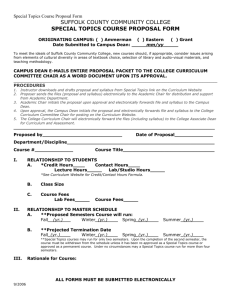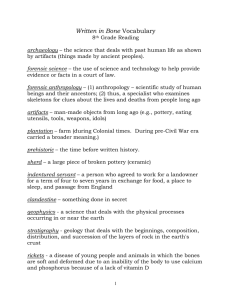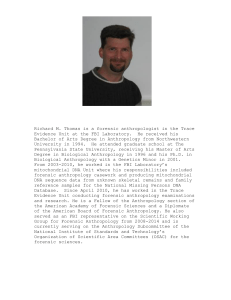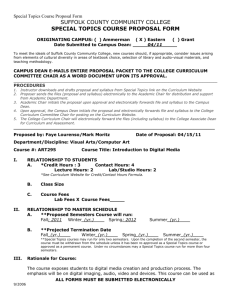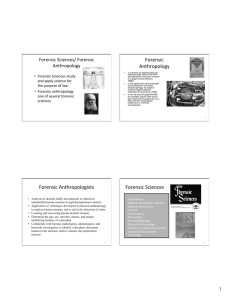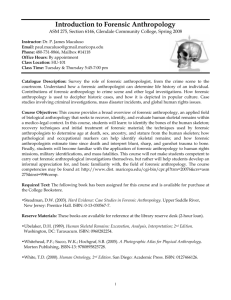ANT295 - Suffolk County Community College
advertisement
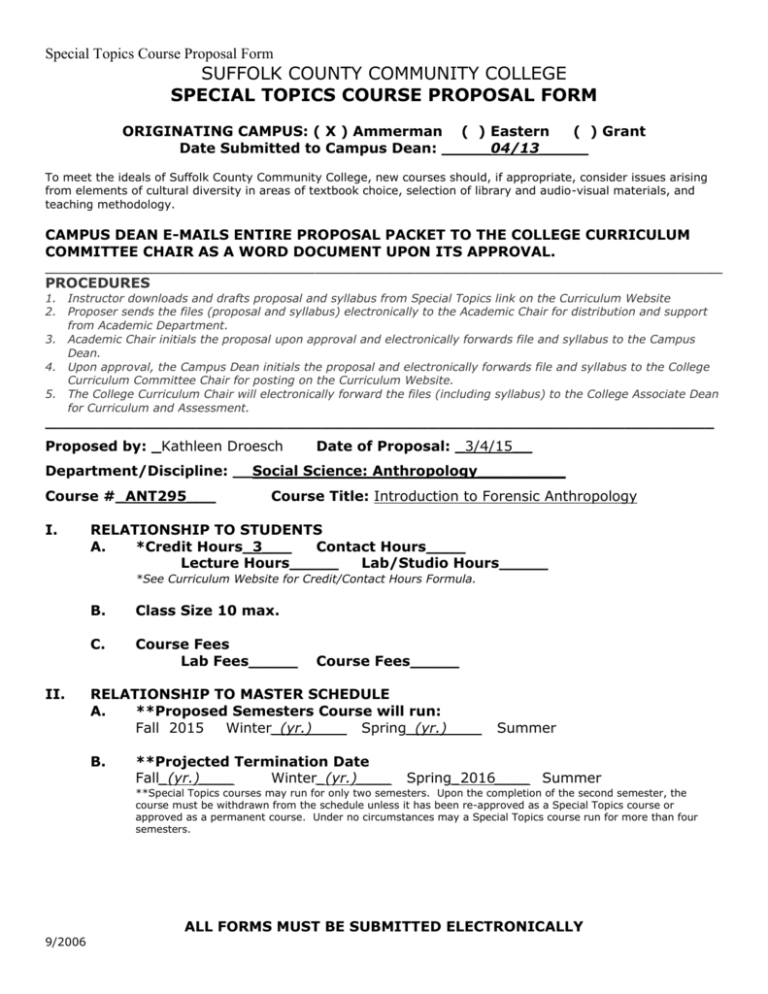
Special Topics Course Proposal Form SUFFOLK COUNTY COMMUNITY COLLEGE SPECIAL TOPICS COURSE PROPOSAL FORM ORIGINATING CAMPUS: ( X ) Ammerman ( ) Eastern ( ) Grant Date Submitted to Campus Dean: _____04/13_____ To meet the ideals of Suffolk County Community College, new courses should, if appropriate, consider issues arising from elements of cultural diversity in areas of textbook choice, selection of library and audio-visual materials, and teaching methodology. CAMPUS DEAN E-MAILS ENTIRE PROPOSAL PACKET TO THE COLLEGE CURRICULUM COMMITTEE CHAIR AS A WORD DOCUMENT UPON ITS APPROVAL. ____________________________________________________________________________________________________________ PROCEDURES 1. Instructor downloads and drafts proposal and syllabus from Special Topics link on the Curriculum Website 2. Proposer sends the files (proposal and syllabus) electronically to the Academic Chair for distribution and support from Academic Department. 3. Academic Chair initials the proposal upon approval and electronically forwards file and syllabus to the Campus Dean. 4. Upon approval, the Campus Dean initials the proposal and electronically forwards file and syllabus to the College Curriculum Committee Chair for posting on the Curriculum Website. 5. The College Curriculum Chair will electronically forward the files (including syllabus) to the College Associate Dean for Curriculum and Assessment. ___________________________________________________________________________ Proposed by: _Kathleen Droesch Date of Proposal: _3/4/15__ Department/Discipline: __Social Science: Anthropology_________ Course #_ANT295___ I. Course Title: Introduction to Forensic Anthropology RELATIONSHIP TO STUDENTS A. *Credit Hours_3___ Contact Hours____ Lecture Hours_____ Lab/Studio Hours_____ *See Curriculum Website for Credit/Contact Hours Formula. II. B. Class Size 10 max. C. Course Fees Lab Fees_____ Course Fees_____ RELATIONSHIP TO MASTER SCHEDULE A. **Proposed Semesters Course will run: Fall 2015 Winter_(yr.)____ Spring_(yr.)____ B. **Projected Termination Date Fall_(yr.)____ Winter_(yr.)____ Summer Spring_2016____ Summer **Special Topics courses may run for only two semesters. Upon the completion of the second semester, the course must be withdrawn from the schedule unless it has been re-approved as a Special Topics course or approved as a permanent course. Under no circumstances may a Special Topics course run for more than four semesters. ALL FORMS MUST BE SUBMITTED ELECTRONICALLY 9/2006 Special Topics Course Proposal Form III. Rationale for Course: This introduction to the recovery and interpretation of human skeletal remains within the context of scientific death investigation will emphasize the multidisciplinary approach which draws upon the fields of physical anthropology, forensic pathology, archaeology, forensic odontology, criminalistics, and other forensic disciplines. An introductory laboratory class in human osteology will include the recognition of human vs. nonhuman material, the assessment of age, sex, race, and the recognition of gross trauma and pathological lesions. IV. Description of Course: Students will learn to identify human bones and teeth, procedures for search and recovery of human skeletal remains, assess age, sex, stature and ancestry of human remains, and understand and describe techniques used to identify an individual, as well as trauma to the skeletal remains. Students will learn how to provide examples of the various applications of forensic anthropology to historical, human rights and mass disaster cases. V. Approvals Department Approval_Judith Travers, Academic Chair Date___March 4, 2015 Campus Dean Approval George Tvelia Date March 4, 2015 Campus Dean ALL FORMS MUST BE SUBMITTED ELECTRONICALLY 9/2006 Special Topics Course Proposal Form SPECIAL TOPICS • COURSE SYLLABUS I. Course Number and Title: ANT 295 – Special Topics in Anthropology II. Description of Course: See above III. Course Objectives: (What should students learn as a result of taking this course and how will they demonstrate that learning?) Upon completion of this course students will be able to: 1. Identify human bones and teeth, including their features, to aid in identification of skeletal unknown 2. Describe the procedures for search and recovery of human skeletal remains 3. Describe and execute techniques used to assess sex, age, stature, and ancestry of human skeletal remains 4. Understand and describe techniques used to identify an individual as well as trauma and taphonomic agents associated with human skeletal remains post mortem. 5. Explain how time since death is estimated 6. Summarize and provide examples of the various applications of forensic anthropology to historical, human rights, and mass disasters cases 7. Achieve a new familiarity and appreciation of forensic anthropology IV. Required Texts and Materials: (List textbooks, newspapers, journals, Internet resources, CD-ROMS, Videos, other teaching materials to be used in the course.) Textbook: Introduction to forensic anthropology; Byers, 4th edition Suggested additional material: Forensic anthropology laboratory manual, Byers, 3 ed. ALL FORMS MUST BE SUBMITTED ELECTRONICALLY 9/2006 Special Topics Course Proposal Form V. Assessment of Student Learning: (Describe assessment measures, i.e., instruments that measure the attainment of course objectives.) 1. Twenty percent (20%) of the course grade will be determined by four (4) quizzes. These will be in class quizzes given during the beginning of the class. Students may drop one (1) quiz. There will be no making up of quizzes. 2. Ten percent (10%) of the final grade will be based on class attendance. You must remain for the entire class in order to get credit. If you have a medical excuse and provide a written note from you physician, that absence will not count against you final grade. 3. Thirty percent (30 %) of the course grade will be determined by the midterm examination. The test will be comprised of multiple choice and essay questions. 4. Thirty percent (30 %) of the course grade will be determined by the final examination. This test will be comprised of multiple choice and essay questions. In addition, skeletal feature identification will be included in the final examination. Questions will be drawn from lecture material, readings and films shown in class. 5. Ten percent (10%) of the course grade will be based o class participation. VI. Date Weekly Outline of Topics and Assignments: Lecture Readings 1 Course Overview Introduction to osteology Chapter 1 2 Osteology Skull Chapter 2 pp 27 to 35 3. Quiz 1 Osteology Axial skeleton Appendicular skeleton 4. Craniometrics Forensic odontology Cadaver lab 5. Quiz 2 Forensic significance Mapping Chapter 2 pp 35 to 39 Chapter 2 pp 39 to 51 No readings Chapter 3 ALL FORMS MUST BE SUBMITTED ELECTRONICALLY 9/2006 Special Topics Course Proposal Form 6. Recovery methodology Inventory of remains Ice Man mystery Chapter 4 7. Midterm Time since death Chapter 5 8. Ethnicity Determination of sex Chapter 7 Chapter 8 9. Quiz 3 Determination of ontogenic age Chapter 9 Estimation of stature, body mass Chapter 10 10. Death and Trauma Projectile Trauma Chapter 11 Chapter 12 11. Blunt trauma Sharp trauma Chapter 13, Chapter 14 12. Postmortem changes to bone Skeletal pathology Chapter 16 Chapter 15 13. Quiz 4 Identification Facial reconstruction 14. Mass graves Final Examination Chapters 17, 18 ALL FORMS MUST BE SUBMITTED ELECTRONICALLY 9/2006
